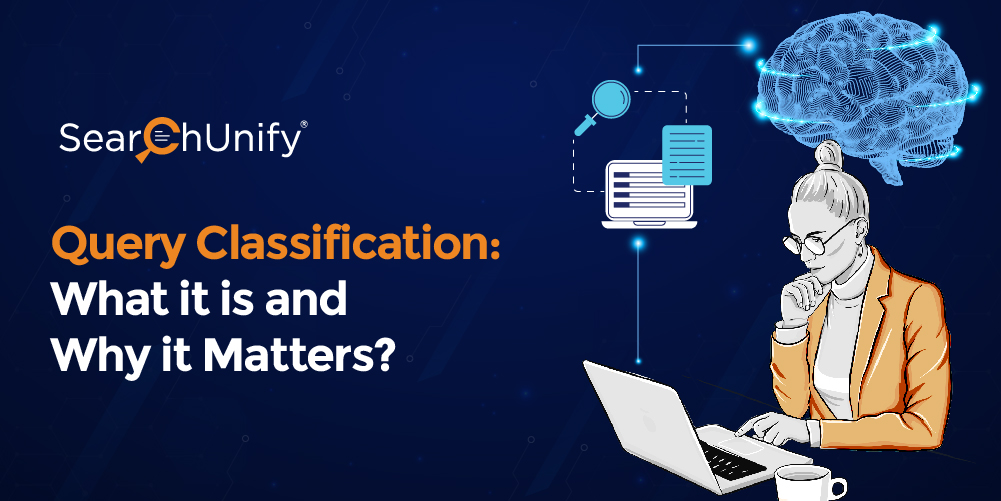
Human language is complex, ambiguous, and diverse. Comprehending the written and spoken word is a piece of cake for humans. However, it can be quite challenging for computers or machines.
Thousands of queries are run every second, and classifying them in the correct class is paramount for generating relevant search engine results pages. This is where query classification kicks in.
In this post, we’ll discuss what happens under the hood to correctly classify queries. We’ll also shed light on how cognitive technology leverages query classification to revolutionize content findability and ameliorate search experiences.
What is Query Classification?
Query classification is the process of deconstructing and assigning queries to one or more cohorts based on the topic in question. Cognitive engines have the ability to organize incoming queries in meaningful ways and identify the categories they belong to, thus making it easier to search through big data volumes and retrieve relevant information.
They do so by decrypting the syntax and semantics of the data to infer characteristics of the entity and extracting the intent from the content respectively. Too long-winded to understand? Fret not. This example will simplify it.
Mr. X wishes to know if the company is declaring Good Friday a holiday. So, he types a search query in the company’s in-house chat portal – ‘Are we getting off on Friday?’. On the other hand, Ms. Y searches, ‘Is the coming Friday working?’
Now, a cognitive system first recognizes that ‘we’ here refers to the firm’s employees. Thereafter, it parses ‘get off’ in its real context; wherein get off means ‘getting a day off from work’ as opposed to something like ‘getting off the car.’ Additionally, the system taps into natural language understanding (NLU) algorithms to proactively learn and identify synonyms, abbreviations, and misspelled words.
How Does a Cognitive Platform Deconstruct Queries?
To correctly infer the query context and user intent, cognitive platforms rely on syntactic and semantic analysis to disambiguate words and sentences. Here’s how:
- Syntactic Analysis: Also referred to as parsing, syntactic analysis gives us the dictionary meaning of a sentence or its parts. It also analyzes the sentence structure and the text’s incoherence in accordance with the formal grammar.
- Semantic Analysis: It involves drawing meaning from text. Machines use an automated process called Word Sense Disambiguation to determine the correct meaning of a word or sentence in the given context. Lexical semantics play a pivotal role in semantic analysis by allowing machines to understand relationships between lexical items (like words, phrasal verbs, etc.) by using techniques like stemming and lemmatization.
To illustrate, syntactic analysis alone would return irrelevant results for the query “an orange date theme.” This is because the word orange can refer to a color, fruit, or even city (in Florida); while the word ‘date’ can either mean a particular day of the month, a fruit, or a meeting.
But when paired with semantic analysis, the system can easily decipher the exact meaning of the query, i.e., an orange-colored theme for date night. Once that is sorted, AI algorithms assign these queries to predefined classes, thereby providing relevant and high-converting search results to users.
How Does Query Classification Augment the Search Experience?
The adoption of query classification unlocks an elevated user experience in the following ways:
1. Enables Synonym Mapping:
Users don’t search with keywords in mind; they search with intent. For instance, a user searches for ‘mobile phone’ but your documentation is for ‘smartphone.’ Chances are the SERP will display – No results found.
You can steer clear of this dreadful situation by mapping synonyms. Once synonyms are defined, AI algorithms rank the content pieces containing the words searched or their variations. What’s more, it also takes care of singular and plural nouns along with stop words (like ‘how to’ & ‘why is’) to ensure nothing obstructs the delivery of relevant information.
2. Boosts Relevance:
To put it simply, relevancy means providing results that are as pertinent to the search query as possible. Hence, understanding the context of search queries becomes non-negotiable. Query classification is the standard method that parses out the context and intent from searches. Doing so automatically improves accuracy and enables the engine to return results that are logical, precise, and on the beam to serve the user’s purpose.
3. Ameliorates Findability:
Since the window to provide accurate answers is rather narrow, it is imperative to deliver the most relevant content first. This is exactly what query classification helps you achieve. It leverages taxonomy to add consistent metadata to the content. Once the metadata of content is in place, the findability of relevant content improves by leaps and bounds.
Drive & Deliver Relevant Experiences with Cognitive Technology
Understanding users’ needs and then timely delivering relevant information is no longer mission impossible. How? Simply jump on the AI bandwagon and reap the benefits of intelligent search powered by a cognitive platform.
Want more insights into how cognitive platforms catapult UX by correctly understanding and classifying user queries? Then, this e-book is for you. Afterward, if you wish to witness how it all works in real-time, then feel free to request a demo!


















